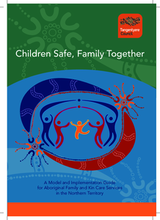‘Children Safe, Family Together', the new family and kin care model outlined in this paper forms an integral part of the overall strategy being currently implemented by Territory Families (TF) to transform Out-of-Home Care in the Northern Territory (NT). The strategy addresses worrying trend data pointing to the significant over-representation of Aboriginal and Torres Strait Islander children in the NT child protection system. The strategy also seeks to reinforce the voices of Aboriginal organisations and communities for the Out-of-Home Care sector (OOHC) in the NT to honour the primacy of family and kin, and ensure the continued connection of Aboriginal and Torres Strait Islander children to language, land and culture as expressed in the Aboriginal and Torres Strait Islander Child Placement Principle. Furthermore, it aims to transition family and kin care service delivery to Aboriginal community controlled organisations and increase the decision making power of Aboriginal children, families, communities and organisations in relation to the care and protection of Aboriginal children. This is a fundamental step towards increasing community control and self-determination for Aboriginal people and communities.
The model acknowledges that children are best placed in their family home, and that it is critical that all potential strategies and active efforts are exhausted in supporting the preservation of families, in order to prevent the need for removal. It also acknowledges that in instances where the removal of the child is necessary, timely family reunification is always the best and most desired outcome. With these acknowledgements in mind, the model focuses on providing safe, stable and best possible placements for Aboriginal children in those instances where removal is a necessity and reunification, despite best efforts, has not yet been achievable.
Implementing the model involves transferring the process of providing family and kin care services from TF to ACCOs over a five year period in a way that ensures coverage of the service across the whole of the NT while providing maximum delivery flexibility in response to the geographical and population diversity of the NT. Every ACCO who takes on delivery of the model, or specific phases of it, will need to consider how it can be adapted and aligned to the needs of the region, families and communities that they intend to serve.
The suggested approach involves facilitating service provision to centres of greatest population density (hubs) as well as smaller population centres (spokes) while simultaneously accommodating purchaser provider and collaborative approaches and developing the capacity of ACCOs ideally to deliver all four phases of family and kin care services described above. A step by step guide to implementation of the model is presented in section 4 of this paper together with implementation recommendations. A number of recommendations are proposed as part of this model which aim to address the issues identified in each phase. These recommendations are listed below and further expanded on within the phase they pertain to. A list of ‘light bulb’ recommendations are also provided which outline new and innovative ideas or overarching suggestions that should be implemented to create tangible improvements to outcomes for Aboriginal children and carers in family and kin care placements.

